A year ago I gave my old AirPods to Kayla because the batteries didn’t last very long. Now they’ve reached the point where they only last 5 minutes on a charge. I’m pretty handy at replacing batteries in iPhones and Watches so I looked up info on how to do it for AirPods. And then I looked at how much Apple charges to replace the batteries ($49 per Airpod, $98 for the pair). And then I found PodSwap. So I ordered a swap for $60. If you have an old pair of AirPods needing new batteries, try them and save 10%.
Tag: technology
Superchargers Visited
Superchargers Visited is a silly and fun Tesla owners game I’m playing. I have a Tableau page showing the Superchargers I have, and have not (default view) visited.
The game might be one of the reasons I drove to Tampa for a meeting instead of flying. Fun facts: about 8k miles driven, 146 Superchargers visited, 11 days, and $409.23 in electricity.
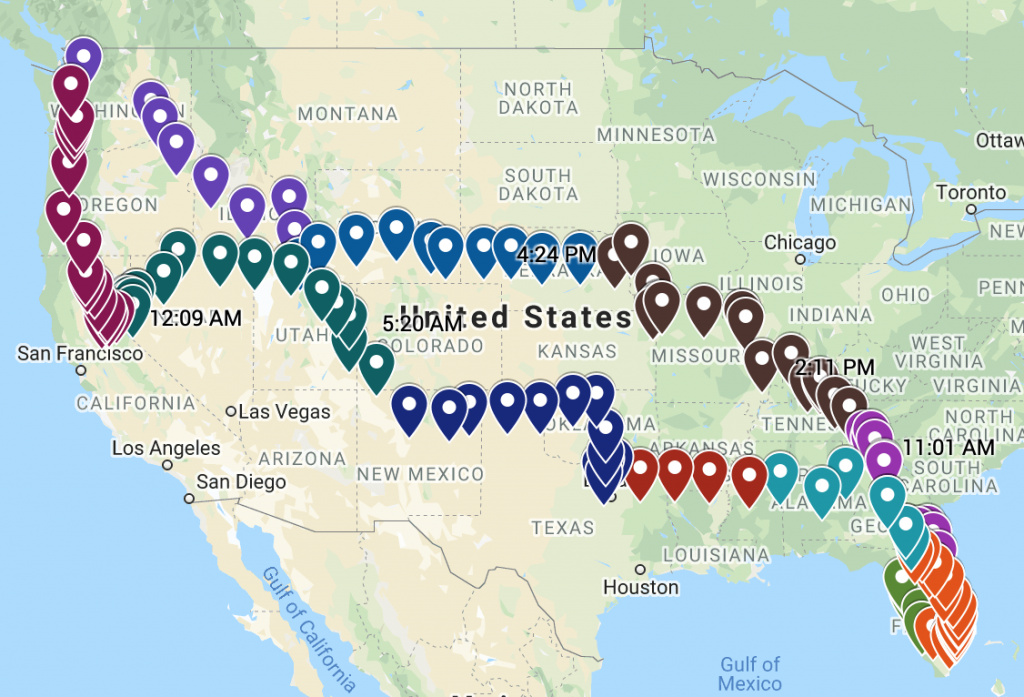
Note to my future self: with two drivers tag team driving, keeping the wheels in motion when not refueling, expect to cover about 1,000 miles per day in fair weather.
FrankenYak
I recently obtained this lovely new yard ornament named Yak.
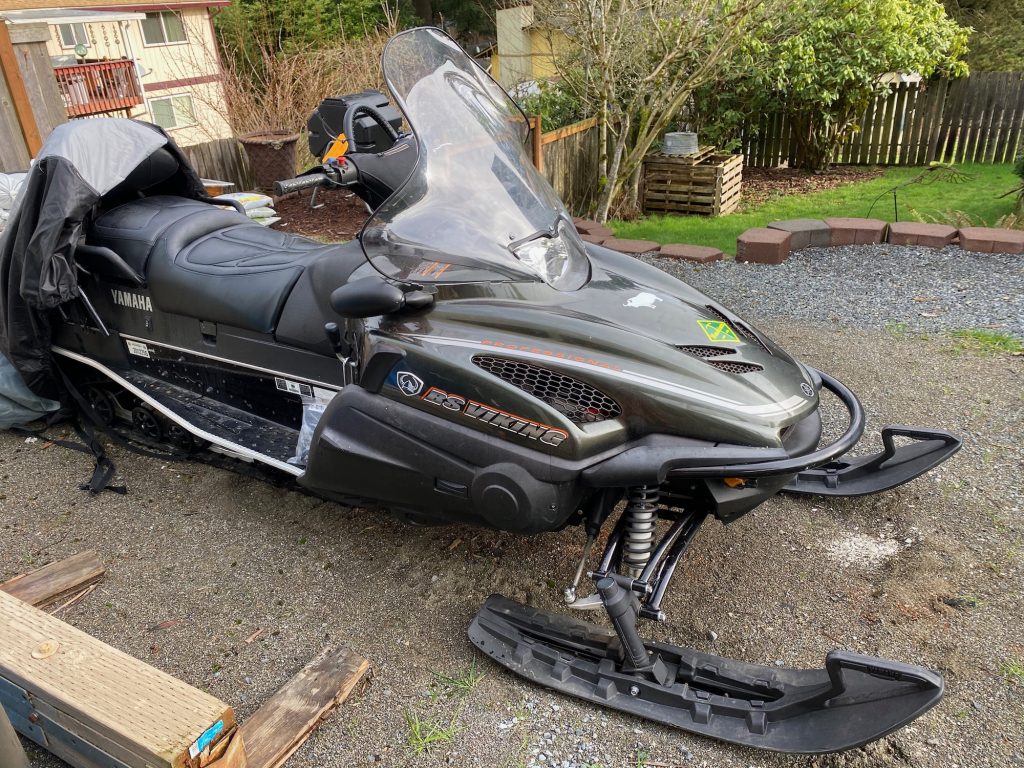
Yak is 1/3 of our snowmobile fleet at Meany Lodge. Our main winter transport for the 3 miles from Crystal Springs Sno-Park to the Lodge is Tomcat which can haul 35 people + gear. We use the snowmobiles for the many smaller transport tasks such as hauling large sleds full of groceries and gear to and from the car park.
This machine suffered a mechanical failure and the cost of repair exceeds the machines value. Instead of disposing of Yak, I intend to strip the 4-cycle ICE powertrain and replace it with an electric motor and a DIY Li-Ion battery pack. The project is just getting started as I’ve purchased a box of battery cells to experiment with and started searching for the lightest and most efficient 100HP motor I can find.
When it is complete and we have demonstrated a minimum viable product (the ability to drive to and from the Sno-Park with sufficient reserve capacity), I hereby promise to impersonate the canonical “It’s Alive” scene.
EV FAQ: how long does it take to charge?
One of the most common questions people ask about our Electric Vehicles is how long it takes to charge them. I’ve answered this in a variety of ways but I’m not sure I’ve ever fully answered the question. Part of the reason people are concerned with charge time is because one of the primary inconveniences of driving a car has been gassing it up. You must drive to a station, wait for a pump, insert a payment card, wait for authorization, select a fuel type/grade, start the pump, and then stand outside in the weather to monitor it. With a BEV, the vast majority of charging happens in your garage or driveway. Thus my answers tended to highlight this difference in “filling up” paradigms.
- “About 30 seconds. I plug it in when I get home and unplug when I leave.”
- “It depends on what I’m plugged into.”
- “It doesn’t matter, because it charges while I’m sleeping.”
Those answers are valid, but they don’t tell the whole story. That’s because the story is complex. Let’s start with the simplified version.
- Level 1 adds 5 Miles of range Per Hour of Charging
- Level 2 adds 20 MPHC
- DC fast charging adds over 100 MPHC.
EV Charging Levels
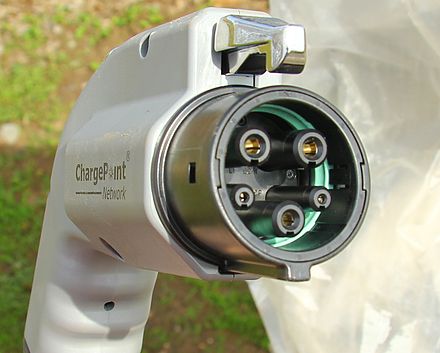
Levels 1 and 2 use standard household (AC) current. The vehicle has an onboard charger that converts household AC current to the DC current which is stored in the battery pack. To charge at levels 1 and 2, a special adapter called an Electric Vehicle Supply Equipment (EVSE) is used. Every EV comes with an EVSE and they all share the common J1772 connector.
Then there is DC fast charging. Since the car doesn’t need to convert the DC current, it can charge the battery as fast the battery can store it. In fact, the car tells the DC charger what rate it can accept and then the charging station delivers as much as it can, without exceeding the cars limit. There are several DC fast charging standards including CHAdeMO (Nissan), Supercharger (Tesla), GB/T (China), and SAE Combo/CCS (everyone else).
Charge Times
Level 1, also known as trickle charging, is the slowest charge rate and uses standard 120V wall outlets that you can find nearly everywhere. On a typical 12-hour overnight charge, a BEV will gain about 60 miles of range. Considering that most people travel under 40 miles per day, L1 is often good enough. Older BEVs like our leased ’13 and ’16 Leafs included an EVSE that supported only Level 1 charging. We found it sufficient in all but the coldest week or two of the year.
Level 2 adds 20 MPHC. Level 2 is the most common and the EVSEs are rated by the maximum power they can deliver. The most common EVSE uses the 50A NEMA 14-50 plug, draws 32 amps continuous, and adds about 240 miles of range overnight. The NEMA 14-50 is the same outlet commonly used for electric ranges, ovens, generators, and RVs. You can often find the 14-50 plug in kitchens, garages, and campgrounds across America. The EVSE included with our ’19 Leaf and ’19 Tesla Model 3 both sport a NEMA 14-50 plug. If your garage doesn’t have one, getting a NEMA 14-50 outlet installed is a good bet. Be advised though, ask your electrician for an “oven outlet,” as many electricians have charged hundreds of dollars more for an EV outlet than the identical oven outlet.
If you already have a 240V outlet of any sort in your garage, there are 3rd party EVSEs with plugs matched to nearly any standard 240V outlet. A dryer, welder, air conditioner, or generator outlet in your garage is sufficient. Lower rated (~3.3kW) EVSEs can be found for $200-$300 whereas a reputable (ChargePoint, Clipper Creek, JuiceBox) 8kW EVSE will run about $500. If you have a Tesla, you can buy $35 adapters for the included EVSE for all the common 240V plug types.
DC Fast Chargers require more electricity than a house and are industrial machines. They are typically found at commercial buildings (like Nissan dealers) and along major highways. Whereas L1 and L2 stations are typically used at home, DCFCs are typically used on longer trips. Here’s a few examples of DC fast charging rates:
- Our Tesla Model 3 Long Range can add 125 miles in 15 minutes, or 267 MPHC
- The Chevy Bolt & Nissan Leaf can add 30 miles per 10 minutes, and 120 MPHC.
Careful readers may have noticed that the peak charge rate is substantially higher than the MPHC. That’s because Li-Ion batteries (just like in your phone/tablet/laptop) must be charged slower as they approach full. The tapering is much more pronounced with DCFC and it’s done to protect the battery. In fact, it is the car that tells the charger the rate at which it can accept power. Most EVs charge at their full rate up to about 80% and then taper. Because of tapering, long road trips in a BEV mean your trip will take less time if you charge to 80% and then leave for the next charging station. Tesla actually does this for you–it will charge enough to get to the next Supercharger (plus some margin) and then suggest hitting the road.
| Level | Volts | Amps | MPHC | kW |
| 1 | 120 | 12 | 4-5 | 1.4 |
| 2 | 240 | 35-80 | 20-50 | 3.3 – 15 |
| DC – CHAdeMO | 500 | 125 | up to 140 | usually 50, up to 62.5 |
| DC – CCS | 200-1000 | < 500 | depends | up to 350 |
| DC – Tesla SuperCharger | 480 | 300 | 267 | 140 |
Tesla has ruined me
Habits are funny things. We develop them after performing a repetitive task for about 2 months. Having formed the habit, we continue doing the same actions but we tend to forget that we used to need to think about the actions. Habits let us be unaware that we’re still performing them.
Having driven autos for nearly 3 decades, I had a collection of driving habits I no longer thought about. Driving my Tesla Model 3 for a while has let some of them fade away. This came into focus this weekend while driving 400 miles to Moses Lake and back for a math competition.
- Braking. With a Battery EV (BEV), letting up on the accelerator initiates regenerative braking. The car uses the motor to slow the vehicle and store that kinetic energy in the battery. It doesn’t take long to become proficient at one pedal driving. About the only time braking is required is to bring our Tesla from a slow roll to a complete stop. While driving an older vehicle on this trip, I found myself thinking about braking: when to start, how much, why doesn’t this car have “brake hold,” and “oh yeah, I must press that brake pedal!”
- Starting: For 100 years cars had ignitions. Starting a car is a series of steps:
- Fish the keys out of wherever you stowed them
- Insert the correct key into the ignition
- Twist the key to start the engine
- Release the key immediately after the engine starts
- Depress the brake and/or clutch
- Release the emergency brake
- Shift into gear
- Press the accelerator to drive away
- Manual transmissions also require a synchronized release of the clutch and accelerator. Newer hybrids remove a step as they automatically start and stop the gas engine as needed. Some cars have smart keys that let you leave your key in your purse or pocket.
- Until you try to teach someone else to drive, or get used to driving a BEV, it’s easy to forget how elaborate the startup ritual is. A Tesla has no start button. The steps in our Tesla are:
- Step on the brake and shift into gear.
- (if enabled): enter the PIN code.
- Press the accelerator to drive away.
- Stopping a typical car has a similar sequence:
- Shift the car into park (or gear)
- Turn off the ignition
- Set the parking / emergency brake
- Exit the car (and wait for everyone else to exit the car)
- Lock the car
- Store the keys
- To stop driving a Tesla, you shift into park, get out, and walk away. If you’re at home and the battery is low, you might also pause to plug it in. A Tesla sets the emergency brake upon shifting into Park and releases it upon shifting into another gear. It automatically locks the car as you walk away.
- My phone is my Tesla key and it can remain in my pocket. There is no ignition nor clutch. There’s not even a transmission: just a gearbox with a single gear. As a result of not needing to perform the typical sequences for a couple months, it’s entirely possible that over the course of 400 miles and 8 stops that at least once I:
- tried opening the car door before unlocking the car.
- got in, fastened my seatbelt, looked at the dash expectantly, unfastened my seatbelt, fished the keys out of my pocket, stuck the keys in the ignition, and refastened my seatbelt.
- was reminded by the sound of the running engine to get back in and turn the car off.
- started driving before releasing the emergency brake.
- returned to the car to lock it, upon remembering that it won’t lock itself.
The Nissan Leaf is finally good enough
In 2012 we dipped our toes into the Electric Vehicle waters with a Ford Fusion hybrid. The Fusion uses the gas engine to charge the battery. The small battery can propel the car up to around 25 mph on level ground. Seeing how far I could drive in EV only mode become something of a sport and was the first step towards an all-electric vehicle.
In 2013 the Nissan Leaf was updated with a more efficient heater that got more range in cold weather. We calculated that it would be “just enough” battery to cover Jen’s 40 mile daily commute in mid-winter when headlights, defrosters, and heaters are needed in both directions. We stepped into the shallow end of the BEV market by signing a 3 year lease on a Leaf. The only issue we ran into was only having a Level 1 (120V) charger at home. During the coldest weeks of winter, charging is slower and plugging in when she arrived home wasn’t enough time to get a full charge by morning. After a week of very cold days, by Friday she wouldn’t have enough range and would take the Fusion instead. I got permission to install a Level 2 charge in our rented home, but never did.
In 2016 Nissan introduced the 107 mile battery. When our lease ended I handed our Nissan dealer the 2013 keys and leased a ’16 Leaf. That 30 miles of extra range let the Leaf do a bit more. We took it up to Steven’s Pass skiing, to Lummi Island for the weekend, and to Meany Lodge. We had to limit the highway speed to 60 and bring the charger so we could plug in upon arrival. When explaining the range limits to people, I found myself saying the ’13 Leaf battery was good enough 90% of the time. The ’16 battery was good enough 98% of the time.
Now my Nissan dealer has Leafs with 151 mile batteries. By the end of the month they’ll have the Leaf+ in stock with a 226 mile battery. Our lease ends in May. If we lease another Leaf, it will finally be good enough.
Solar 11-month update
On a typical “it rained every single day in April” month, we still managed to skate across the finish line at nearly at Net Zero:

Last year I removed all the natural gas appliances and converted everything to electric heat pumps. I sized the 10kW array aiming for Net Zero during the calendar year. That would mean producing enough surplus during the summer to carry us through the winter. It looks like we’re going to miss this year:
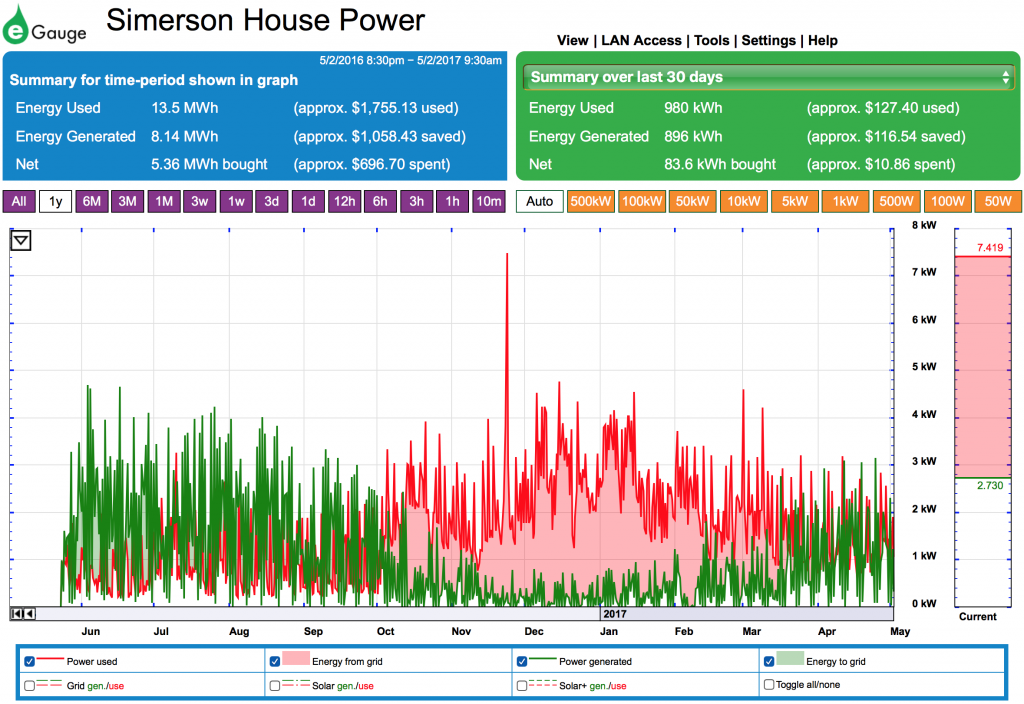
Even though we’ll be banking surpluses in May, it won’t close that 7MWh deficit. Our household usage includes over 3MWh of car charging and this last winter was Seattle’s coldest in 32 years. The heat pumps were working overtime to keep the house warm.
Who’s Afraid of the TPP?
Who’s Afraid of the Trans-Pacific Partnership?
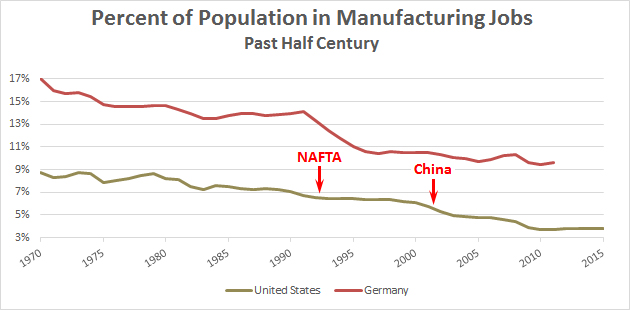
Very roughly speaking, DeLong’s argument is this: everyone agrees that Germany is the poster child for an advanced economy with a great manufacturing policy. And yet, their manufacturing employment has steadily declined for the past half century too, just like ours. So if this has happened to Germany, there’s not much of a case for suggesting that the US has done anything especially wrong over the past 50 years. We’ve simply evolved from a (relatively) poor manufacturing nation into a (relatively) rich services and technology nation. This has nothing much to do with trade policy, either. It’s just what rich countries do. What’s more, it’s a decidedly good thing overall, even if it does affect a smallish number of people badly.
This is not terribly different than agricultural employment. At the turn of the 20th century about half of US workers were employed in agriculture. A hundred years later as we skated past Y2K it is about 2%.
How Many People?
How many people does it take, as a minimum, to maintain our current level of technological civilization?
Insufficient Data by Charles Stross.
Is a change of political climate in the air?
On May 21st, leaders representing 6.5 million companies in 130 countries called on policy makers to shift towards low-carbon economies including carbon pricing and an end to fossil-fuel subsidies.
Yesterday, June 1st, Six oil and gas “Majors” called on the UN Convention on Climate Change to introduce carbon pricing and markets.
If this keeps up, Fox News will admit climate change is real, Rick Perry will admit that government can create jobs, and lions will lay down with lambs.


You must be logged in to post a comment.